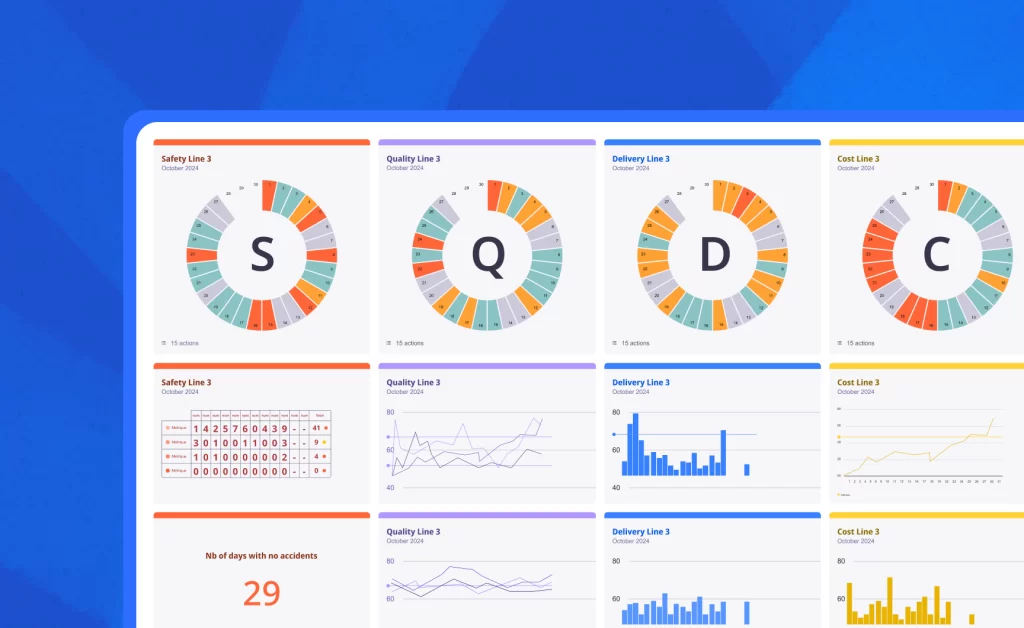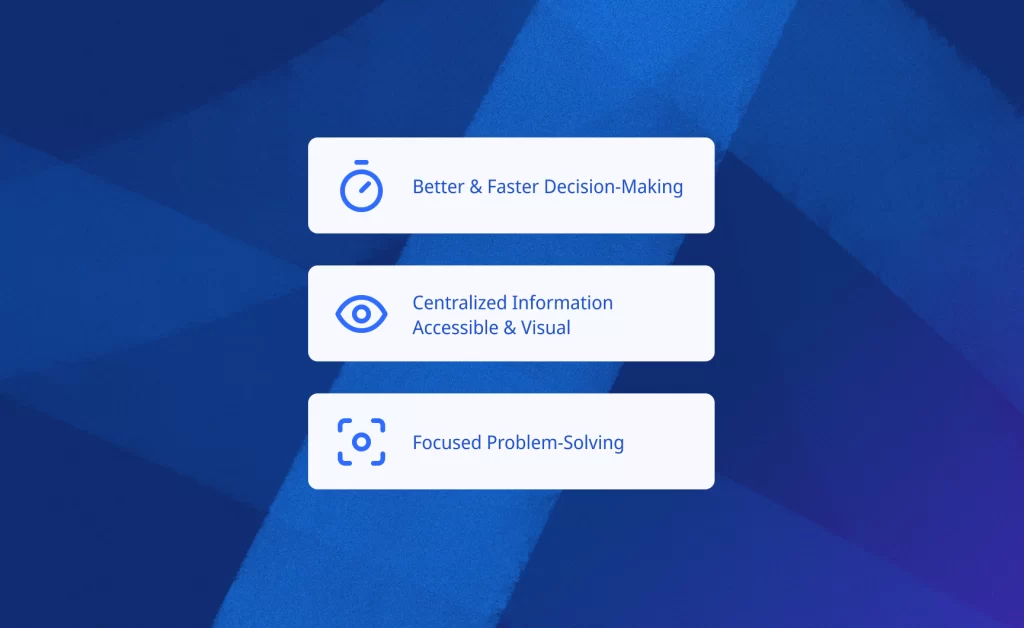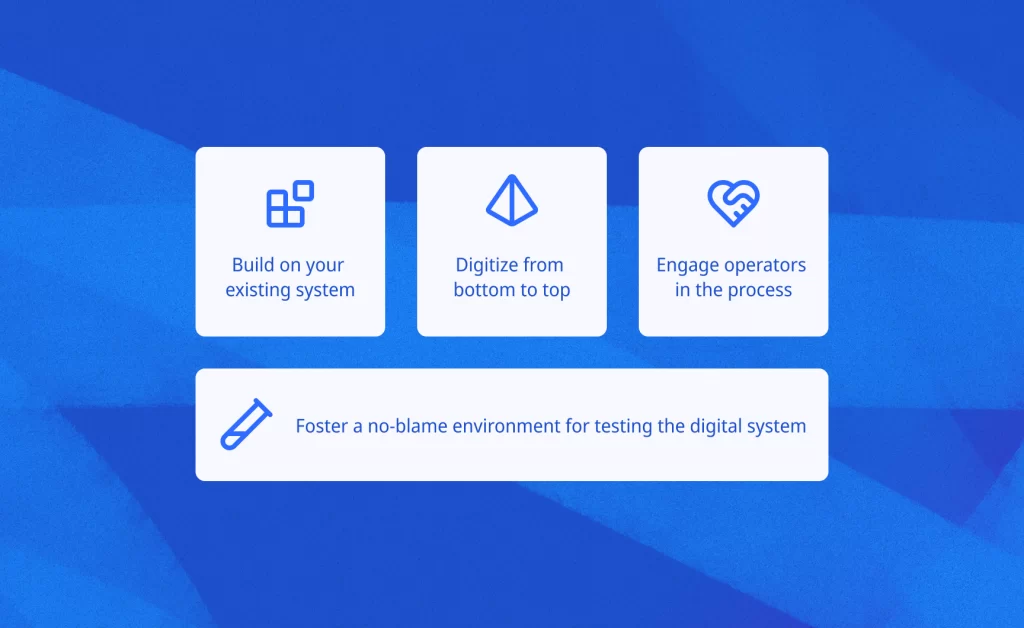Hey, let’s start your
iObeya journey!
Achieving operational excellence is essential for factories, including manufacturing, assembly lines, plants, mills, fabrication sites, processing centers, production facilities, and more. One of the most effective ways to ensure optimal performance, efficiency, and collaboration is through the digitization of Daily Management Systems (DMS). In this blog post, we will explore the challenges of traditional paper and hybrid DMS, the advantages of digitization, and provide practical tips for implementing a digitized DMS in your factory .
The Critical Role of Tiered Systems for Operational Efficiency
In a well-functioning Lean Daily Management System (DMS), a tiered system plays a crucial role in maintaining operational efficiency. This system is divided into multiple levels or “tiers” (e.g., T1, T2, T3, T4), with each tier corresponding to a different organizational level, from frontline operators to executive management. The beauty of a tiered system is in its ability to escalate and consolidate information efficiently. When issues arise at lower tiers, they are quickly escalated to higher tiers, ensuring that unresolved problems are addressed promptly. On the other hand, key decisions, insights, and directives are consolidated at upper tiers and then cascaded down.
A typical structure might start with Tier 1 at the team level and escalate to Tier 2 for mid-management, followed by Tier 3 for senior leaders, and finally Tier 4 for top executives. This interconnectedness creates a seamless flow of communication, allowing teams to stay aligned and tackle challenges with the right level of visibility and support.
Challenges of Paper-Based or Hybrid Daily Management Systems
Many factories continue to rely on paper-based or hybrid systems (a combination of digital and paper methods) to manage their daily operations. In many cases, organizations use spreadsheets and documents that are shared across teams and manually updated—an approach that lacks the robustness required for modern manufacturing environments. One such example is SQCD+ (Safety, Quality, Cost, Delivery, People), one of the most widely used paper-based daily management practices that we see. While these methods may have been effective in the past, they present several limitations that restrict visibility into performance and impede process efficiency.
Information may not be synchronized or accurate
In a paper or hybrid system, it’s common for data to be out of sync due to manual update error or latency. Different teams might be working with outdated information, leading to confusion and mistakes. This can lead to misalignment across tiers. As a result, teams or management may unintentionally shift focus from the core issue they’re trying to solve as they try to piece together conflicting, inaccurate, or outdated information
High effort to update
Updating paper-based or hybrid systems requires manual effort, often resulting in delays. Teams must spend valuable time tracking down data or making sure documents are current in all places where stakeholders will be seeking this information. This delays the tiered escalation process, as teams may miss critical updates.
Risk of information loss
Paper documents can be lost, damaged, or misplaced, resulting in gaps in data continuity. This is especially problematic when critical decisions need to be made quickly. If feedback loops are not well-established, it can often be unclear when escalated actions are being addressed by upper management, or if the correct information on the resolution has made it to the relevant contributors.
Limited data access
With paper systems, data is often siloed, making it difficult for teams and managers to access the information they need in real time. Hybrid systems can also suffer from this issue if they’re not properly integrated. Escalations paths become harder to track, and teams may not know whether upper-tier management is informed of or addressing road blocks, barriers or other specific issues.
These challenges ultimately slow down decision-making, reduce operational visibility, and lead to inefficiencies across the entire tiered system.
Advantages of Digitizing Daily Management Systems
The shift to digitized daily management systems can transform how a factory operates, enabling faster and more informed decision-making. Here’s how digitizing your DMS can drive operational excellence:
Better & Faster Decision-Making
Digitizing DMSs accelerates decision-making by dramatically shortening the feedback loop. Paper-based systems can take 24-48 hours or longer to fully update teams, whereas digital systems provide instant updates, reducing the feedback loop to ½ a day on average. This speed enables faster, more informed decisions, as data is synchronized and accessible real-time. With one source of truth, teams can trust that they are working with the most accurate and current information.
Centralized Information – Accessible & Visual
A digital system centralizes all critical information, making it easily accessible to everyone, from operators to upper management. Beyond accessibility, digitized systems also make data highly visual, allowing teams to monitor KPIs or other performance metrics at a glance. This visibility across all tiers enables teams to quickly grasp key insights and take action, something that’s far more difficult with paper-based systems.
Focused Problem-Solving
With a digital DMS, teams are better equipped to solve the problems they originally set out to address. Given that data is accurate and continuously updated, there is less risk of drifting away from the core issue. Teams can remain aligned and focused on addressing the root problem without getting sidetracked by outdated or incomplete information.
Tips for Implementing a Digitized Daily Management System in Your Factory
Implementing a digitized DMS requires a strategic approach to ensure success. Here are some key tips to keep in mind as you make the transition:
Build on your existing system
To successfully implement a digitized DMS, you need to have a solid foundation in place. Start with an existing daily management system that includes three key elements:
- Regular daily meetings
- with a visual component and a structured agenda, where team members actively collaborate and drive the discussions.
- A clear KPI tree, ensuring that key performance indicators are well-defined and understood by everyone.
- An established escalation process for problems, so that issues are addressed in a timely and structured manner.
If you already have these elements in place, focus on digitizing the processes that are already working well. Work to maintain the structure of your meetings, KPI tree, and escalation process while enhancing them through digital tools.
Digitize from bottom to top
Begin digitization at the granular level, focusing on the processes closest to the operators. Ensure that the system is built from the ground up, eventually connecting all levels of the organization. Don’t forget to extend this pyramid all the way to top management, ensuring a complete digital flow of information.
Engage operators in the process
A key element of successful digitization is ensuring that the system works with operators, not against them. The new system should make their lives easier, not more complicated. Minimize the number of clicks and make the user interface as intuitive as possible. If the digital system requires more effort than the old paper-based system, it will face resistance. This is why a digital system that is similar to paper-based rituals is beneficial as it makes the transition seamless.
Foster a no-blame environment for testing the digital system
During the transition, there will inevitably be hiccups. To prevent anxiety or resistance, establish a no-blame environment where small mistakes are acceptable and viewed as learning opportunities. Operators and managers alike should feel comfortable testing the system without fear of repercussions. Implementing a test environment can help operators feel safe as they explore and familiarize themselves with the new tool.
The Power of Digitized Daily Management Systems for Decision Making and Operational Excellence
By transitioning to a digitized Daily Management System , factories can achieve greater efficiency, foster better decision-making, and make a critical step in their operational excellence journey. The key is a thoughtful, well-planned implementation that engages everyone from operators to executives. When done correctly, the benefits of digitization will extend beyond just saving time and reducing paperwork—it will empower teams, drive continuous improvement, and ultimately boost the factory’s bottom line. Digitizing daily management practices like SQCDP+ allows enterprises of any industry to not only maximize their impact, but also gives enterprises a competitive advantage by better aligning with modern business demands when leveraged correctly.









